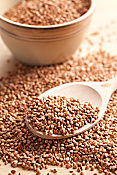What is Gluten

Gluten (from Latin gluten, "glue") is a protein composite found in foods processed from wheat and related grain species, including barley and rye. Gluten gives elasticity to dough, helping it rise and keeps its shape and often gives the final product a chewy texture. Gluten may also be found in some cosmetics, hair products, and other dermatological preparations.
Gluten is the composite of a gliadin and a glutenin, which is conjoined with starch in the endosperm of various grass-related grains. The prolamin and glutelin from wheat (gliadin, which is alcohol-soluble, and glutenin, which is only soluble in dilute acids or alkalis) constitute about 80% of the protein contained in wheat fruit. Being insoluble in water, they can be purified by washing away the associated starch. Worldwide, gluten is a source of protein, both in foods prepared directly from sources containing it, and as an additive to foods otherwise low in protein.
The fruit of most flowering plants have endosperms with stored protein to nourish embryonic plants during germination. True gluten, with gliadin and glutenin, is limited to certain members of the grass family. The stored proteins of maize and rice are sometimes called glutens, but their proteins differ from true gluten.
Sources of gluten:
Several grains and starch sources are considered acceptable for a gluten-free diet. The most frequently used are corn, potatoes, rice, and tapioca (derived from cassava). Other grains and starch sources generally considered suitable for gluten-free diets include amaranth, arrowroot, millet, montina, lupin, quinoa, sorghum (jowar), taro, teff, chia seed, and yam. Sometimes various types of bean, soybean, and nut flours are used in gluten-free products to add protein and dietary fiber.
The term gluten-free generally is used to indicate a supposedly harmless level of gluten rather than a complete absence. The exact level at which gluten is harmless for people with celiac disease is uncertain and controversial. A 2008 systematic review tentatively concluded that consumption of less than 10 mg of gluten per day for celiac disease patients is unlikely to cause histological abnormalities, although it noted that few reliable studies had been conducted.
Regulation of the label, gluten-free, varies widely by country. In the United States, the FDA issued proposed regulations in 2007 limiting the use of "gluten-free" in food products to those with less than 20 parts per million of gluten. The current international Codex Alimentarius standard allows for 20 parts per million of gluten in so-called "gluten-free" foods.



